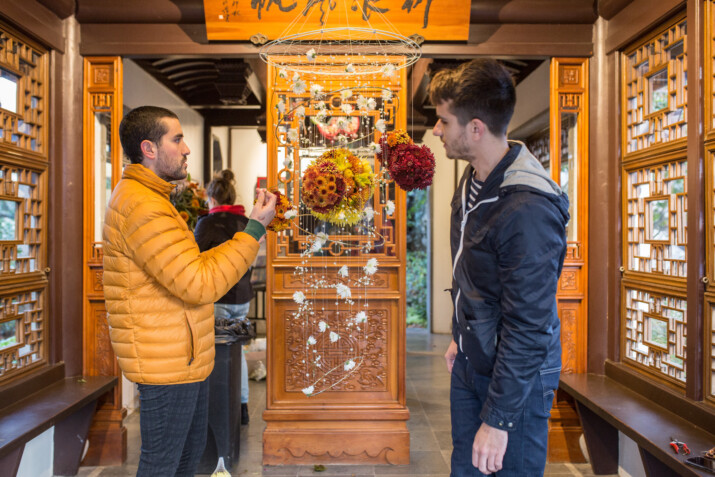Portland, July 25th, 2013. The Oregon Zoo this week began its yearlong treatment regimen for Rama, the Asian elephant who cultured positive for tuberculosis in late May, officials announced. Zoo staff is also preparing to administer preventive treatment to Packy, who reacted to a subsequent blood-serum test and could have a latent infection.
“Packy has shown no signs of active TB,” said Mitch Finnegan, the zoo’s lead veterinarian. “But lab work on his blood indicates possible exposure, so it’s better to treat this now than risk an active infection down the line.”
The zoo routinely tests all its elephants for TB by taking an annual trunk culture (collecting fluid from the animal’s trunk and sending it to a certified laboratory for testing) as part of its comprehensive health program and in compliance with U.S. Department of Agriculture standards. Following Rama’s diagnosis last month, each of the elephants was retested, with preliminary results coming back negative once again for all but Rama.
As a further precaution, the zoo also submitted blood samples from each of its elephants for testing, using the serologic DPP (Dual Path Platform) assay, a broad but useful screening test. Packy, in addition to Rama, was reactive to this assay, so his blood serum was submitted for further testing. A more specific test known as MAPIA (multi-antigen print immunoassay) indicated possible exposure to TB. While only a positive trunk culture test is considered definitive, Dr. Finnegan — in consultation with the USDA — has recommended treating Packy as the most prudent course of action.
“For elephants, we are using the MAPIA the same way we’d look at a TB skin test for humans,” Dr. Finnegan said. “It doesn’t necessarily indicate active tuberculosis — it indicates exposure to the TB bacteria at some point in the past. In humans, only a small percentage of those who react positively to the skin test ever develop TB, and treating a latent TB infection reduces that risk even further. That’s the course we’ll be taking with Packy.”
Dr. Finnegan said neither Rama nor Packy have shown any signs of illness and, although Rama is being kept apart from the herd during his treatment, no similar measures are needed for Packy at this time.
“TB is typically very manageable,” Dr. Finnegan said. “Neither elephant has shown signs of being sick, and we’re hopeful that with proper treatment they never will. Getting early results like this is very helpful and the prognosis is good for both animals.”
After receiving the initial report about Rama in late May, Dr. Finnegan immediately contacted the public health authorities and veterinarians at the Oregon Department of Health and Human Services and U.S. Department of Agriculture. Zoo personnel were also informed of the results, and those working in prolonged close proximity to Rama were tested to ensure they did not have the disease.
Zoo visitors were not at risk, according to Justin Denny, M.D., public health officer for Multnomah, Washington and Clackamas counties.
“Transmission of tuberculosis requires prolonged periods of close contact,” Dr. Denny said. “So we wanted to make sure we tested anyone who spent time close to Rama. But as far as the general public is concerned, there is nothing to worry about.”
It took until this month to amass enough medication to begin Rama’s treatment regimen, which began on Tuesday, but now that the medicine is on site, Packy’s treatment can begin starting next week. The zoo’s veterinary staff will monitor both elephants’ progress through trunk cultures and blood tests during their prescribed treatment regimen.
While not common, TB has been reported in elephants as far back as 1875 and has a history of successful treatment at several North American elephant facilities.
The Oregon Zoo is recognized worldwide for its Asian elephant program, which has spanned more than 50 years. Considered highly endangered in their range countries, Asian elephants are threatened by habitat loss, conflict with humans and disease. It is estimated that fewer than 40,000 elephants remain in fragmented populations from India to Borneo.
The zoo is a service of Metro and is dedicated to its mission of inspiring the community to create a better future for wildlife. Committed to conservation, the zoo is currently working to save endangered California condors, Oregon silverspot and Taylor’s checkerspot butterflies, western pond turtles and Oregon spotted frogs. Other projects include studies on Asian elephants, polar bears, orangutans and giant pandas. Community supported since 1888, the zoo relies in part on donations through the Oregon Zoo Foundation to undertake these and many other animal welfare, education and sustainability programs.
The zoo opens at 9 a.m. daily and is located five minutes from downtown Portland, just off Highway 26. The zoo is also accessible by MAX light rail line. Visitors who travel to the zoo via MAX receive $1.50 off zoo admission. Call TriMet Customer Service, 503-238-RIDE (7433), or visit www.trimet.org for fare and route information.
















